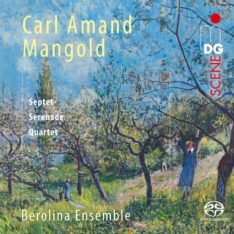Wer bei Mangold nur an spinatähnliches Gemüse denkt, kennt Carl Amand, eigentlich Carl Ludwig Amadeus, Mangold nicht. Dieser mit dem Hof in Darmstadt verbundene Komponist hatte auch enge Bande nach Paris, die es ihm ermöglichten, für die Neue Zeitschrift für Musik von Robert Schumann aus dem Musikleben der französischen Hauptstadt zu berichten. Im gleichen Jahr wie Verdi und Wagner geboren, komponierte er zeitlich mit Wagner unter einem anderen Blickwinkel eine Tannhäuser Oper. Opern und andere dramatische Werke mag man als Schwerpunkt seines Wirkens ansehen.
Mangolds umfangreiches Werk, sowohl im Hinblick auf Gattungen wie auch die Zahl der Werke, ist praktisch in Vergessenheit geraten. Das Ensemble Berolina hebt drei Stücke der Kammermusik, die auch ungewöhnliche Besetzungen haben. Die lassen sich wohl mit den ihm zur Verfügung stehenden Musikern in Darmstadt begründen.
Mit dem Berolina Ensemble hat sich wieder eine Gemeinschaft von Musikern gefunden, die als feste Gruppe, aber in unterschiedlichen Besetzungen, meist aus Streichern und Bläsern, vernachlässigte Musik von heute unbekannten Musikern aufleben lässt. Dass sie dabei auch veritable Entdeckungen machen, ist ein weiterer positiver Aspekt ihrer Suche.
Das von ihnen vorgestellte Septett in der gleichen Besetzung wie das Werk von Beethoven hat einen charmanten Charakter und fordert auch die solistischen Fähigkeiten der Musiker. Ein hörenswertes Werk! Die Serenade, ein dreisätziges Bläserquintett, trägt schon die aparte Art im Titel. Die Bläser des Berolina Ensembles wissen diese Komposition mit eloquentem und frischem Spiel zu einem wahren Kleinod zu gestalten. Das Quartett für Streicher ist ungewöhnlich mit einem Kontrabass statt einer zweiten Geige besetzt. Wenn es auch in dieser Zusammensetzung nicht allein steht, als bekanntere Namen seinen Dotzauer und Hoffmeister erwähnt, ergänzt es die Auswahl aufs Beste. Mit herausgehobener Stellung der Geige als Solistenquartett konzipiert, kann es auch mit seiner reizvollen Begleitung punkten. Die vier Instrumentalisten dieser Einspielung interpretieren das Werk ebenso flockig im Ton wie technisch hoch versiert, so dass man die Kompositionen von Carl Amand Mangold gern im Ohr behält.
Anyone who only thinks of spinach-like vegetables when they think of Mangold (chard in English) does not know Carl Amand, actually Carl Ludwig Amadeus, Mangold. This composer, who was connected to the court in Darmstadt, also had close ties to Paris, which enabled him to report on musical life in the French capital for Robert Schumann’s Neue Zeitschrift für Musik. Born in the same year as Verdi and Wagner, he composed a Tannhäuser opera at the same time as Wagner, but from a different perspective. Operas and other dramatic works may be regarded as the focus of his work.
Mangold’s extensive oeuvre, both in terms of genre and the number of works, has been practically forgotten. The Ensemble Berolina performs three pieces of chamber music with unusual instrumentation. These can probably be explained by the musicians available to him in Darmstadt.
With the Berolina Ensemble, a community of musicians has once again come together to revive neglected music by today’s unknown musicians as a permanent group, but in different formations, mostly consisting of strings and wind instruments. The fact that they also make veritable discoveries in the process is another positive aspect of their search. The septet they present, in the same instrumentation as Beethoven’s work, challenges the musicians’ soloistic skills, despite its charming character, making it a work well worth hearing.
The Serenade, a three-movement wind quintet, already bears the distinctive character in its title. The wind players of the Berolina Ensemble know how to turn this composition into a real gem with their eloquent and fresh playing. The quartet for strings is unusually scored with a double bass instead of a second violin. Although it does not stand alone in this composition – Dotzauer and Hoffmeister are mentioned as better-known names – it complements the selection perfectly. Conceived as a soloist quartet with the violin in a prominent position, it also scores with its attractive accompaniment. The four instrumentalists on this recording interpret the work with both a relaxed tone and a high level of technical skill, making Carl Amand Mangold’s compositions a pleasure to listen to.


















